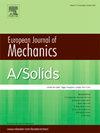Additive manufacturing of a transtibial prosthetic socket through a FE-based topology optimization approach
IF 4.2
2区 工程技术
Q1 MECHANICS
引用次数: 0
Abstract
The present work explores the possibility of combining 3D printing and topology optimization to produce lightweight transtibial prosthetic sockets to reduce the manufacturing time, costs and material waste. Specifically, a topology optimization algorithm based on Finite Element (FE) method has been employed to determine the optimal material distribution for the prosthetic socket in Polyamide PA12. A FE analysis has been carried out to validate the behaviour of the optimized shape. Finally, the new shape has been 3D printed using the fused deposition modelling technology. Furthermore, a cost analysis has been performed on the 3D printed part and traditional prosthetic socket. The approach followed in the present work showed a time reduction of up to 50% for the production of the final prosthesis and a cost reduction of up to 80% compared to the traditional manufacturing process. Moreover, the optimization of the material distribution allows for a reduction of material use (i.e. −38%). This procedure demonstrates the potential of the proposed approach for developing an efficient and sustainable alternative in the manufacturing of prosthetic sockets.

基于有限元拓扑优化方法的增材制造胫骨假体窝
本研究探索了将3D打印和拓扑优化相结合的可能性,以生产轻量级的胫骨义肢套,以减少制造时间、成本和材料浪费。具体而言,采用基于有限元法的拓扑优化算法确定了聚酰胺PA12假体孔的最佳材料分布。进行了有限元分析,以验证优化形状的性能。最后,使用熔融沉积建模技术对新形状进行3D打印。此外,还对3D打印部件和传统假肢插座进行了成本分析。在目前的工作中所采用的方法表明,与传统的制造工艺相比,最终假体的生产时间减少了50%,成本减少了80%。此外,材料分布的优化允许减少材料使用(即- 38%)。这一过程证明了所提出的方法的潜力,即开发一种高效和可持续的替代方法来制造假体插座。
本文章由计算机程序翻译,如有差异,请以英文原文为准。
求助全文
约1分钟内获得全文
求助全文
来源期刊
CiteScore
7.00
自引率
7.30%
发文量
275
审稿时长
48 days
期刊介绍:
The European Journal of Mechanics endash; A/Solids continues to publish articles in English in all areas of Solid Mechanics from the physical and mathematical basis to materials engineering, technological applications and methods of modern computational mechanics, both pure and applied research.

 求助内容:
求助内容: 应助结果提醒方式:
应助结果提醒方式:


